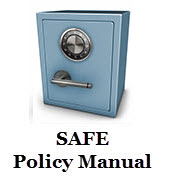|

|
State Accounting Fiscal Essentials
.
SAFE Policy Manual
|
Revised: 04/03/2023
|
Payees
Applicable or Related Code Sections
Related Links

PURPOSE
This policy provides general guidance for agencies, offices, boards, and commissions to register new organizations or individuals to receive payment and when current Payees want to make changes to information on file.
SCOPE
This policy applies to all state agencies, offices, boards, and commissions for expenditures made from funds within the state treasury.
DEFINITIONS
- “Administrator”: An OhioPays user with all Associate privileges and enhanced rights to manage other users and the profile information for themselves or the organization they are authorized to act on its behalf. The Administrator can add, update, and/or remove addresses, contacts, electronic funds transfer information and add or revoke user access to the Associates for which they are an Administrator.
- “Associate”: An OhioPays user with rights to view purchase orders, invoices, and payment information for themselves or their organization.
- “EFT”: Electronic Funds Transfer is a method of payment that directs funds electronically to the Payee’s financial institution account through the provision of the Payee’s financial institution routing/transit number and account number. It is the default payment type.
- “OH|ID”: The official identity management solution for the state of Ohio’s online government services. An OH|ID is required to access and register in the OhioPays Portal.
- “OhioPays Portal” or “Portal”: A self-service application to register for payment when doing business with the state, maintain and update Payee address and personal information, method of payment, manage users, and view real-time status of purchase orders.
- “Payee”: Any organization or individual legally entitled to receive payment from a state agency, office, board, or commission from the state treasury; formerly referred to as a supplier or a vendor.
- “Warrant”: Has the same meaning as ORC Section 131.01(S), commonly known as a “paper check”.
PROVISIONS
The Office of Budget and Management (OBM) is responsible for the collection and maintenance of all data submitted by State of Ohio Payees registered in the OhioPays Portal or predecessor processes to collect Payee information to make proper payment from the state treasury. Paying agencies should follow and communicate the following processes to their Payees.
- OhioPays Portal
- The OhioPays Portal is the repository of the state’s Payee information.
- All new Payees are required to register using the OhioPays Portal. If the Payee is associated with a business, non-profit, or voluntary organization, an Administrator must be identified who will be responsible for establishing all new users of the Portal for their organization. Registration of Payees by other means is at the sole discretion of OBM.
- New Payees must have an OH|ID account before accessing the OhioPays Portal. When visiting the OhioPays Portal for the first time, the Payee will be directed to the OH|ID site to create an account.
- All Payees must provide EFT payment information.
- To ensure an efficient and accurate issuance of Internal Revenue Service (IRS) Form 1099, each Payee is responsible to provide a valid business name (if applicable), IRS tax identification number/employer identification number (TIN/EIN), and address in the Portal. Any update or correction to this information must be made immediately by the Payee in the OhioPays Portal.
- State Employees as Payees
State employees should not register in the OhioPays Portal to receive reimbursement of any expenses related to their employment with the state. Such reimbursements are required to be paid through the OAKS Travel and Expense module.
- Payees Without EFT Information
- Any decision to accept paper forms in lieu of registration in the OhioPays Portal is determined at the sole discretion of OBM. The paying agency is responsible to work with the Payee to complete the forms and must perform due diligence to ensure that they are reasonably assured of the identity of the person submitting forms and that person is authorized to do so on behalf of the Payee.
- OBM will review all forms for completeness and accuracy. After the review is completed and the information is validated, OBM will record the Payee information in FIN for purposes of adding the Payee to the state’s payment database. The Payee will not have access to the OhioPays Portal to update or review the information collected.
- Payee Portal Review and Updates
- Payees registered through the OhioPays Portal (and Payees registered in the predecessor Supplier Portal) can review and update their information through the OhioPays Portal.
- Payees can add or delete contact and address information except for the primary address. This same payment information is available in the existing EFT Lookup Database.
- Payees are responsible for the accuracy of any updates.
- Payee’s EFT Account is Closed
If a Payee closes their EFT account registered in the OhioPays Portal, payment requested after such closing will be returned, and a warrant will be issued for that payment. The Payee will have 30 days to submit new EFT information through the Portal to receive payment via EFT.
- Cancelling EFT Payment Information
Requests to cancel EFT as a payment method will be processed at the sole discretion of OBM. The paying agency is responsible for notifying the Payee to complete all cancelation requests and notify OBM of such requests in writing.
- Tax Requirements
OBM, on behalf of the State of Ohio, will provide an IRS Form 1099 to all Payees paid more than $600 from the state treasury in a tax year for goods or services provided in that tax year.
- Liens
OBM on behalf of the State of Ohio, periodically receives an IRS levy notice for Payees. When OBM receives such a notice, it will redirect payments to the IRS until it receives an official release of levy from the IRS.
![]()
